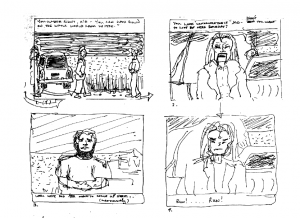Brent C. Reeves and Professor John Lee, Theater & Media Arts
The results thus far of being accepted for the 1996-1997 ORCA scholarship are (1) my first motion picture screenplay, twenty-seven pages in length, (2) various story boarded, or handdrawn and illustrated scenes and sequences from the screenplay, and (3) much gained wisdom and experience in other film making production areas of casting, directing, producing, set design, editing, photography and location scouting and management. These results alone qualify this project, in my mind, as a great success. After all, this kind of education, more than a diploma, is what an aspiring film maker needs, and is only made available to those with the financial means. It is my hope and expectation, however, that even greater success will yet result from the project as it is completed. It is my goal that by September 1, 1998, these pages of screenplay be translated into a film short of approximately twenty-seven minutes in length, to be submitted to the Academy of Motion Picture Arts and Science’s consideration as a candidate for the Academy Award for Best Film Short of 15 to 30 minutes in length, a competition which was established only earlier this year, and to which BYU entries will now, for the first time, be admitted, thanks to the efforts of my projects faculty mentor, John Lee. This is especially significant and fortunate in that a twenty-seven minute film short would have otherwise been impractical — either too long or too short for most festivals and competitions.
It would be impossible I’m sure to chronicle here all that I have experienced and learned to date in the process of this film’s production. I will only document highlights of what I have experienced; a few successes, failures, and problems encountered, which required adapting to.
My project began with a deceivingly simple pitch. I proposed taking a particularly impact full dream, experienced at sixteen years of age, and to recreate it on film for others to see. The first logical step was to write it down in screenplay form. This proved to be an enormous undertaking alone, lasting through a semester-long Screen writing class and finishing as it’s final project. My screenplay received a rarely granted “A” grade, only to endure continued revision and rewrites over a year’s time. But through the laborious and complex project, the power of great dialogue, irony, conflict, symbolism, drama, suspense and humor became very real and thrilling to me, as if tools to be wielded at will. I also learned an essential Screen writing lesson: it is most productive and beneficial, after extensive work, to leave a project alone for a month and come back to it with fresh insight, as well as to seek constant criticisms from varying audiences, then measuring their input against my judgment and making needed changes that otherwise go unseen. I found again and again that, while some of my attempts to artistically communicate to a general audience were either too subtle or too heavyhanded to be effective, such simple, informed adjustments could greatly improve the quality of my viewer/reader’s experience.
Next, I learned to respect through trial and error, the difficult task of story boarding or artistically representing a moving picture on paper. I have included miniature examples of my first attempts hereafter. I have also become acquainted with challenges and tricks of “location scouting,” and I successfully found matching sites that may be used for the actual filming of my screenplay’s unique settings, having to speak with and obtain proper forms of permission from their owners for their use. Another difficult task was to pitch my idea to various talents, gain their trust and interest, and assemble a capable and fitting crew to help create the film. I am currently enrolled in production classes and budgeting courses that will help me to better analyze and finalize the total estimated cost of production, which now stands at $ 10,000, and acquire skills for the management and organization of the production and post-production phases of film making. When completed, except for the remaining balance of the film’s funding, the project will be ready to move forward into completion and submission by the targeted deadline.
Much has been accomplished and new skills and experience have been acquired, but much work and learning is still to be done as the project develops. It is wonderfully difficult to predict what all may come of A Needle’s Eye. But if awarded or even shown in the race for an Academy Award, it could undoubtedly receive great exposure and perhaps result in vital new contacts for myself and my film school. It could prove to be a first essential stepping stone to a successful career in the art of film making. If so, it will all have stemmed from the seed of my ORCA grant which first handed me a license to seriously and freely express my imagination in this way. Receiving the grant was, for me, the starting gun that began this challenging long distance race. For this I am profoundly grateful.

